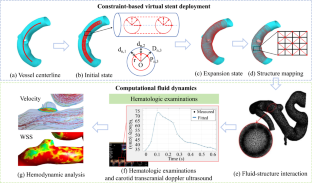International Journal of Computer Assisted Radiology and Surgery ( IF 3 ) Pub Date : 2024-04-15 , DOI: 10.1007/s11548-024-03124-z Zehua Liu , Meng Zhang , Chao Wang , Zhongxiao Wang , Xiangyun Liao , Chubin Ou , Weixin Si

|
Purpose
The internal carotid artery (ICA) is a region with a high incidence for small- and medium-sized saccular aneurysms. However, the treatment relies heavily on the surgeon’s experience to achieve optimal outcome. Although the finite element method (FEM) and computational fluid dynamics can predict the postoperative outcomes, due to the computational complexity of traditional methods, there is an urgent need for investigating the fast but versatile approaches related to numerical simulations of flow diverters (FDs) deployment coupled with the hemodynamic analysis to determine the treatment plan.
Methods
We collected the preoperative and postoperative data from 34 patients (29 females, 5 males; mean age 55.74 ± 9.98 years) who were treated with a single flow diverter for small- to medium-sized intracranial saccular aneurysms on the ICA. The constraint-based virtual deployment (CVD) method is proposed to simulate the FDs expanding outward along the vessel centerline while be constrained by the inner wall of the vessel.
Results
The results indicate that there were no significant differences in the reduction rates of wall shear stress and aneurysms neck velocity between the FEM and methods. However, the solution time of CVD was greatly reduced by 98%.
Conclusion
In the typical location of small- and medium-sized saccular aneurysms, namely the ICA, our virtual FDs deployment simulation effectively balances the computational accuracy and efficiency. Combined with hemodynamics analysis, our method can accurately represent the blood flow changes within the lesion region to assist surgeons in clinical decision-making.
中文翻译:

基于约束的虚拟部署对颈内动脉中小型颅内囊状动脉瘤进行分流器治疗计划
目的
颈内动脉(ICA)是中小型囊状动脉瘤的高发区域。然而,治疗在很大程度上依赖于外科医生的经验来实现最佳结果。尽管有限元法(FEM)和计算流体动力学可以预测术后结果,但由于传统方法的计算复杂性,迫切需要研究与分流器(FD)部署数值模拟相关的快速但通用的方法结合血流动力学分析来确定治疗方案。
方法
我们收集了 34 名患者(29 名女性,5 名男性;平均年龄 55.74 ± 9.98 岁)的术前和术后数据,这些患者在 ICA 上接受单分流器治疗中小型颅内囊状动脉瘤。提出基于约束的虚拟展开(CVD)方法来模拟FD沿血管中心线向外扩展,同时受到血管内壁的约束。
结果
结果表明,有限元法和方法之间的壁剪切应力和动脉瘤颈速度的降低率没有显着差异。然而CVD的溶解时间却大大缩短了98%。
结论
在中小型囊状动脉瘤的典型位置,即ICA,我们的虚拟FD部署模拟有效地平衡了计算精度和效率。结合血流动力学分析,我们的方法可以准确地表示病变区域内的血流变化,以协助外科医生进行临床决策。



























 京公网安备 11010802027423号
京公网安备 11010802027423号